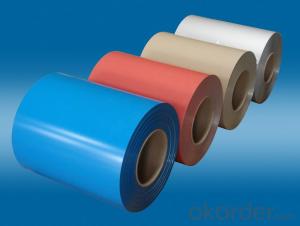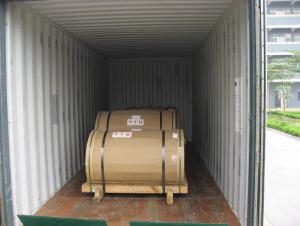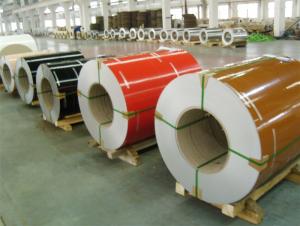Coated Aluminum Coils AA1xxx
- Loading Port:
- China Main Port
- Payment Terms:
- TT or LC
- Min Order Qty:
- 5 m.t.
- Supply Capability:
- 100000 m.t./month
OKorder Service Pledge
OKorder Financial Service
You Might Also Like
1.Structure of Coated Aluminum Coils AA1xxx Description
Coated Aluminum Coils AA1xxx are of a wide range of colors, which give wonderful appearance no matter in residential and commercial constructions or great exhibition centers.
Coated Aluminum Coils AA1xxx have been widely used in the fields of construction and decoration, electronic applications, lighting decoration, air-condition air pipes, sandwich panels and drainages etc.
2.Main Features of Coated Aluminum Coils AA1xxx
• Superior quality of raw material
• Reasonable and stable chemical composition
• Accurate tolerance
• Goode mechanical property
3.Coated Aluminum Coils AA1xxx Images
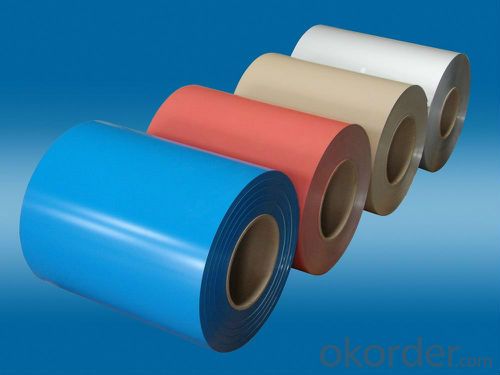

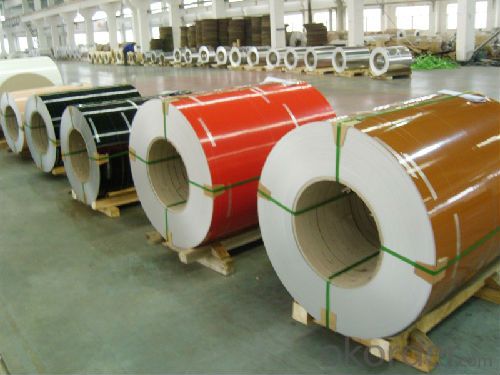
4.Coated Aluminum Coils AA1xxx Specification
Alloy | AA1xxx (AA1050, AA1100 etc.) |
Temper | H14, H16, H18, O/F |
Thickness | 0.2mm -- 100mm |
Width | 30mm -- 1700mm |
Standard | GB/T 3880-2006,EN,JIS |
5. FAQ of Coated Aluminum Coils AA1xxx
A. Where is your mill located?
In Zhejiang Province, China.
B. What is the terms of payment.
L/C ( at sight, 30/60/90 days from B/L date), TT payment.
- Q:What are the different surface protection methods for aluminum coils?
- There are several surface protection methods for aluminum coils, including anodizing, painting, powder coating, and laminating. Anodizing involves creating a protective oxide layer on the surface of the coil, which enhances its resistance to corrosion and wear. Painting involves applying a protective coating of paint, which not only adds an aesthetic appeal but also provides a barrier against environmental elements. Powder coating is a process in which a dry powder is applied electrostatically and then cured under heat, creating a durable and decorative surface finish. Lastly, laminating involves applying a protective film or sheet onto the surface of the coil, providing an additional layer of protection against scratches and abrasions.
- Q:How are aluminum coils stored and transported?
- To ensure the safety and minimize damage of aluminum coils, they are stored and transported in a manner that prioritizes their well-being. Generally, these coils find their place in a warehouse or storage facility, where they are shielded from external elements and potential hazards. They are neatly stacked, taking into account security, and are safeguarded against movement or potential harm by proper padding or spacers. When it comes to transportation, aluminum coils are typically carried in flatbed trucks or shipping containers. These vehicles are equipped with secure tie-downs and restraints that prevent any shifting or damage during transit. It is crucial to ensure the proper securing of the coils to avoid any accidents or mishaps. Moreover, additional precautions are taken during transportation to protect the aluminum coils from potential harm. For instance, the coils may be shielded with protective materials like plastic or fabric, which prevent scratches or dents. In some cases, stretch film or bands may be used to provide extra protection by wrapping or strapping the coils. In summary, the storage and transportation of aluminum coils necessitate careful handling and adherence to safety protocols. This guarantees that the coils maintain their optimal condition and reach their destination without any complications.
- Q:What is the composition of aluminum coils?
- Aluminum coils are typically composed of a pure aluminum core, which is surrounded by a protective coating or cladding material on both sides. The cladding material can vary and may include alloys such as aluminum-manganese, aluminum-magnesium, or aluminum-zinc, depending on the specific application and desired properties.
- Q:Can aluminum coils be used for electrical enclosures?
- Yes, aluminum coils can be used for electrical enclosures. Aluminum is a commonly used material for enclosures due to its excellent conductivity, lightweight nature, and resistance to corrosion. It provides good protection against electromagnetic interference and can effectively dissipate heat. Additionally, aluminum coils can be easily formed and fabricated into various shapes and sizes, making them suitable for electrical enclosures in different applications.
- Q:wikipedia says welding aluminum by means of stick welding is possible but i have always been told TIG is the only way to weld aluminum. what do i need in order to stick weld aluminum? BTW i have a Lincoln Electric AC 225 Stick Welder
- aluminum stick rods are available in various electrode thickness ranges and can be used above 1/8 thickness with an AC machine. The fact that you have an electric machine makes it easier bc the amps and volts stay more consistant than a gas powered unit. I prefer to warm the base metal to about 125 to 150 degrees F prior to welding. Clean the surface area with a STAINLESS STEEL wire brush to remove the oxidation, strike the arc in the normal pattern and then lay the rod back almost parallel with the material and cross arc or long arc against the base metal to allow the material to heat up but not overheat...the weld metal will carry across the arc and drop onto the melted base metal. Good Luck
- Q:What style of womens Oakley sunglasses come in aluminum? I need a tough pair and would like interchangeable lenses option also.
- Best Place for Oakley Sunglasses
- Q:Are aluminum coils suitable for soundproofing applications?
- Aluminum coils are not typically used for soundproofing applications. While aluminum is a good conductor of heat and electricity, it does not have the same sound-dampening properties as other materials commonly used for soundproofing, such as foam, rubber, or dense fibers. These materials are specifically designed to absorb and block sound waves, reducing noise transmission. Aluminum coils, on the other hand, are often used in HVAC systems or as a material for building exteriors due to their durability and heat transfer capabilities. Therefore, if soundproofing is the main objective, it is recommended to consider other materials that are specifically designed for that purpose.
- Q:What's the color coated aluminum roll?
- The so-called color coated aluminum coil, refers to the surface of Aluminum Alloy the coloring process, because Aluminum Alloy properties is very stable, not easy to be corroded, the general surface after special treatment can ensure that at least 30 years do not fade, because of its low density, high hardness, weight of unit volume of metal materials is the lightest. The color of aluminum is a new material recently emerged in the field of the plastic doors and windows, and compared, the biggest advantage is that the degree of firmness and color changing, There is nothing comparable to this, and never faced steel have always been questioned "toxic" two words. Therefore, in high-grade market doors and windows, sunshine rooms, balcony packaging and other fields are widely used. Now, color coated aluminum rolls have become one of the most popular top decorative materials. It is a kind of green with environmental protection, durability and beauty. It has the following advantages as decorative materials unmatched by other products: uniform color, bright and smooth, durable, strong adhesion, acid and alkali corrosion resistance, weathering resistance, decay resistant friction resistance, resistance to ultraviolet radiation, strong weatherability.
- Q:who invented aluminum and or aluminum foil?
- Scientists suspected that an unknown metal existed in alum as early as 1787, but they did not have a way to extract it until 1825. Hans Christian Oersted, a Danish chemist, was the first to produce tiny amounts of aluminum. During that time, the method to extract aluminum was so costly that aluminum once was considered more precious than gold. The plant, owned by J.G. Neher Sons (aluminum manufacturers) started in 1886 in Schaffhausen, Switzerland, at the foot of the Rhine Falls - capturing the falls’ energy to produce aluminum. Neher's sons together with Dr. Lauber discovered the endless rolling process and the use of aluminum foil as a protective barrier. From there began the wide use of aluminum foil in the packaging of chocolate bars and tobacco products. Processes evolved over time to include the use of print, color, lacquer, laminate and the embossing of the aluminum. Although the technology to extract aluminum improved greatly, it still is a energy extensive process. If you, as a chemist can figure out a way to reduce the amount of energy needed to extract aluminum even by 1%, your method can make you a millionaire overnight. There is a thought to motivate you to study Chem. =)
- Q:Are there any specific installation requirements for aluminum coils?
- Yes, there are specific installation requirements for aluminum coils. When installing aluminum coils, it is important to consider a few factors. Firstly, it is crucial to ensure that the coils are properly supported and secured during installation. Aluminum coils can be quite heavy, so adequate support is essential to prevent sagging or damage. This may involve using appropriate brackets or support structures to ensure the coils are securely mounted. Secondly, it is important to consider the location and environment where the coils will be installed. Aluminum coils are often used in HVAC systems, and it is crucial to ensure that the installation area is free from any corrosive substances or chemicals that could potentially damage the coils. Additionally, proper ventilation should be provided to prevent any buildup of heat or moisture, which can affect the performance and lifespan of the coils. Furthermore, it is essential to follow the manufacturer's guidelines and recommendations for installation. This may include specific instructions regarding the type of fasteners or connectors to use, proper spacing between coils, and any other specific requirements for the particular aluminum coil being installed. Adhering to these guidelines will ensure the optimal performance and longevity of the coils. Lastly, it is highly recommended to have the installation of aluminum coils carried out by a professional who is experienced in handling and installing these components. This will ensure that the installation is done correctly, minimizing the risk of any issues or damage that may arise from improper installation. In summary, specific installation requirements for aluminum coils include proper support, consideration of the installation environment, adherence to manufacturer guidelines, and professional installation. Following these requirements will help ensure the optimal performance and longevity of the aluminum coils.
1. Manufacturer Overview |
|
|---|---|
| Location | |
| Year Established | |
| Annual Output Value | |
| Main Markets | |
| Company Certifications | |
2. Manufacturer Certificates |
|
|---|---|
| a) Certification Name | |
| Range | |
| Reference | |
| Validity Period | |
3. Manufacturer Capability |
|
|---|---|
| a)Trade Capacity | |
| Nearest Port | |
| Export Percentage | |
| No.of Employees in Trade Department | |
| Language Spoken: | |
| b)Factory Information | |
| Factory Size: | |
| No. of Production Lines | |
| Contract Manufacturing | |
| Product Price Range | |
Send your message to us
Coated Aluminum Coils AA1xxx
- Loading Port:
- China Main Port
- Payment Terms:
- TT or LC
- Min Order Qty:
- 5 m.t.
- Supply Capability:
- 100000 m.t./month
OKorder Service Pledge
OKorder Financial Service
Similar products
New products
Hot products
Related keywords
